Implementation MSD16: Difference between revisions
| Line 71: | Line 71: | ||
2) Adequately deal with sudden change in direction<br> | 2) Adequately deal with sudden change in direction<br> | ||
3) Filter out measurement noise<br> | 3) Filter out measurement noise<br> | ||
Especially tasks 2) and 3) are conflicting, since the filter cannot determine whether a measurement is “off-track” due to noise, or due to an actual change in direction (e.g. caused by a collision with a player). In contrast, tasks 1) and 3) are closely related in the sense that if measurement noise is filtered out, the prediction will be more accurate. These two relations mean that apparently tasks 1) and 2) are conflicting as well, and that a trade-off has to be made.<br> | |||
The main reason to know the (approximate) ball position at all times is that the supervisor and coordinator can function properly. For example, the ball moves out of the field of view (FOV) of the system, and the supervisor transitions to the ‘Search for ball’ state. The coordinator now needs to assign the appropriate skills to each agent, and knowing where the ball approximately is, makes this easier. This implies that task 1) is the most important one, although task 2) still has some significance (e.g. when the ball changes directions, and then after a few measurements the ball moves out of the FOV).<br> | |||
A solution to this conflict is to keep track of 2 hypotheses, which both represent a potential ball position. The first one is using a ‘strong’ filter, in the sense that it filters out measurements to a degree where the estimated ball hardly changes direction. The second one is using a ‘weak’ filter, in the sense that this estimate hardly filters out anything, in order to quickly detect a change in direction. The filter then keeps track whether these hypotheses are more than a certain distance (related to the typical measurement noise) apart, for more than a certain number of measurements (i.e. one outlier could indicate a false positive in the image processing, while multiple outliers in the same vicinity probably indicate a change in direction). When this occurs, the weak filter acts as the new initial position of the strong filter, with the new velocity corresponding to the change in direction.<br> | |||
This can be further expanded on by predicting collisions between the ball and another object (e.g. players), to also predict the moment in time where a change in direction will take place. This is also useful to know when an outlier measurement really is a false positive, since the ball cannot change direction on its own.<br> | |||
Currently, the weak filter is not implemented explicitly, but rather its hypothesis is updated purely by new measurements. In case two consecutive measurements are further than 0.5 meters removed from the estimation at that time, the last one acts as the new initial value for the strong filter. <br> | |||
When a new measurement arrives, the new particle velocity v_new is calculated according to<br> | |||
<math>v_{new}= \alpha_{v}v_{old}</math> | |||
==Player position filter and sensor fusion== | ==Player position filter and sensor fusion== | ||
Revision as of 20:58, 4 May 2017
Tasks
The tasks which are implemented are:
- Detect Ball Out Of Bound (BOOP)
- Detect Collision
The skill that are needed to achieve these tasks are explained in the section Skills.
Skills
Detection skills
For the B.O.O.P. detection, it is necessary to know where the ball is and where the outer field lines are. To detect a collision the system needs to be able to detect players. Since we decided to use agents with cameras in the system, detecting balls, lines, and players requires some image-processing. The TURTLE already has good image processing software on its internal computer. This software is the product of years of development and has already been tested thoroughly, which is why we will not alter it and use it as is. Preferably we could use this software to also process the images from the drone. However, trying to understand years worth of code in order to make it useable for the drone camera (AI-ball) would take much more time than developing our own code. For this project, we decided to use Matlab's image processing toolbox to process the drone images. The images comming from the AI-ball are in the RGB color space. For detecting the field, the lines, objects and (yellow or orange) balls, it is more convenient to first transpose the image to the YCbCr color space.
Detect lines
Detect balls
Detect objects
Refereeing
B.O.O.P.
Collision detection
Locating skills
Locate agents
Locate objects
Path planning
The path planning block is mainly responsible for generating optimal path for agents to send it as a desired position for their controllers. In the system Architecture, the coordinator block decides about the skill that needs to be performed by agents. For instance, this blocks sends detect ball for agent A (drone) and locate player for agent B as a task. Then, path-planning block requests from the World-Model latest information about the target object position and velocity as well as the position and velocity of agents. Using information, the Path-Planning block will then generate reference point for an agent controller. As it is shown in Fig.1, it is assumed that the world model is able to provide position and velocity of objects like ball whether it has been updated by agent camera or not. In the latter case, the particle filter gives an estimation of ball position and velocity based on dynamics of the ball. Therefore, it is assumed that estimated information about an object which is assigned by coordinator is available.
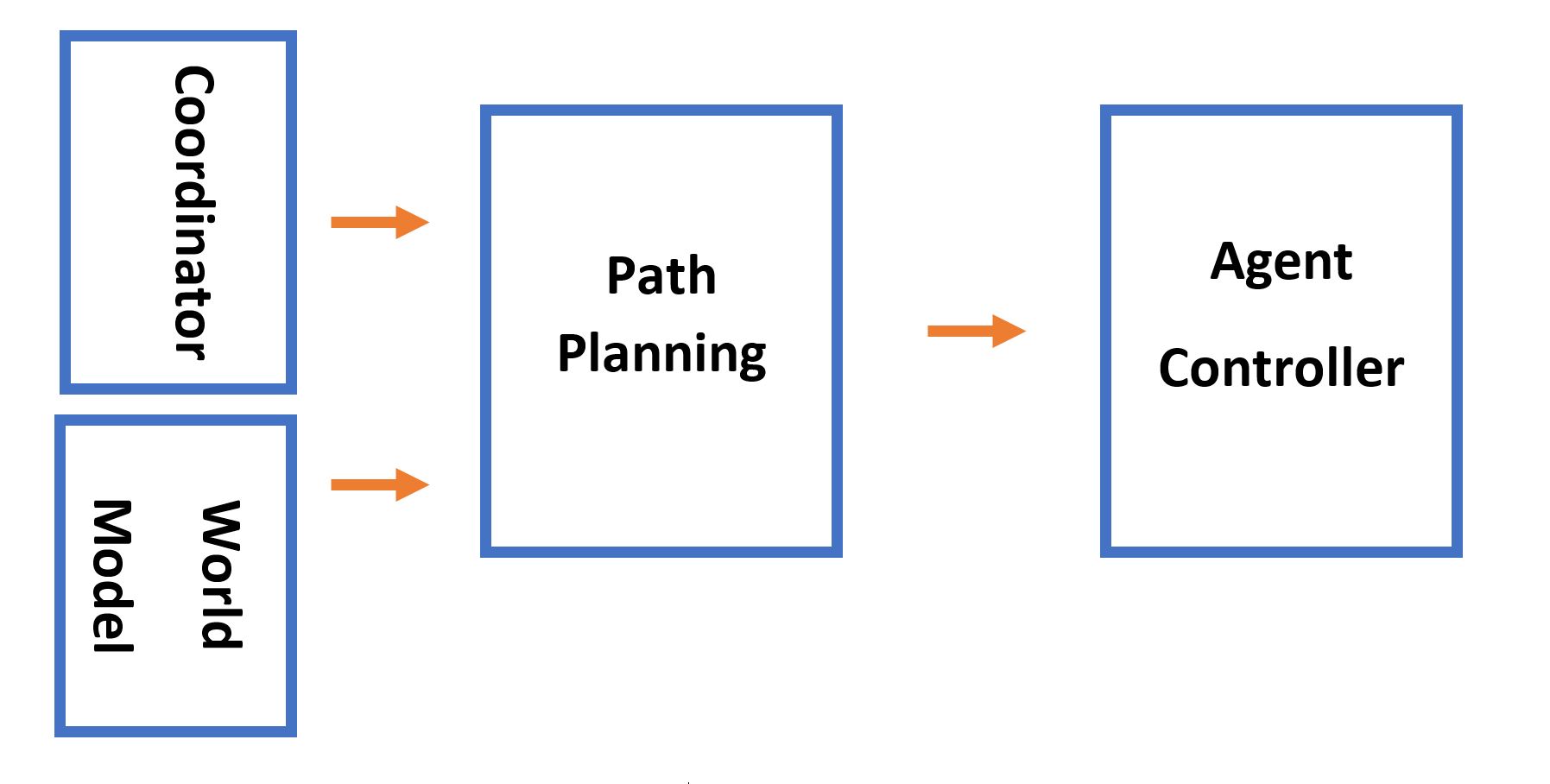
There are two factors that have been addressed in the Path-Planning block. The first one is related to the case of multiple drone in order to avoid collision between them. Second, generating an optimal path as reference input for drone controller.
Reference generator
As we discussed earlier, the coordinator assigned a task to an agent for locating an object in a field. Subsequently, the world model would provide the path planner with the latest update of position and velocity of that object. Path-Planning block simply could us the position of the ball and send it to agent controller as a reference input. This could be a good decision when the agent and the object are relatively closed to each other. However, it is possible to take into account the velocity vector of the object in an efficient way.
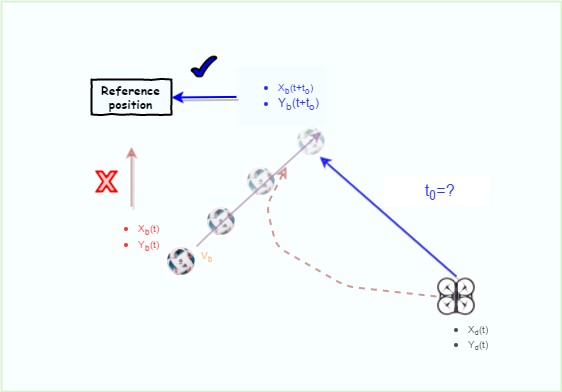
As it is shown in Fig.2, in a case of far distance between drone and ball, the drone should track the position ahead of the object to meet it in the intersection of the velocity vectors. Using the current ball position as a reference input would result in a curve trajectory (red line). However, if the estimated position of the ball in time ahead sent as a reference, the trajectory would be in a less curvy shape with less distance (blue line). This approach would result in better performance of tracking system, but more computational effort is needed. The problem that will be arises is the optimal time ahead t0 that should be set as a desired reference. To solve, we require a model of the drone motion with the controller to calculate the time it takes to reach a certain point given the initial condition of the drone. Then, in the searching Algorithm, for each time step ahead of the ball, the time to target (TT) for the drone will be calculated (see Fig.3). The target position is simply calculated based on the time ahead. The reference position is then the position that satisfies the equation t0=TT. Hence, the reference position would be [x(t+t0), y(t+t0)], instead of [x(t), y(t)]. It should be noted that, this approach wouldn’t be much effective in a case that the drone and object are close to each other. Furthermore, for the ground agents, that moves only in one direction, the same strategy could be applied. For the ground robot, the reference value should be determined only in moving direction of the turtle. Hence, only X component (turtle moving direction) of position and velocity of the interested object must be taken into account.

Collision avoidance
When Drones are flying above a field, the path planning should create a path for agents in a way that avoid collision between them. This can be done in collision avoidance block that has higher priority compared to optimal path planning that is calculated based on objective of drones (see Fig.4). Collision Avoidance-block is triggered when the drones state meet certain criteria that indicate imminent collision between them. Supervisory control then switch to the collision avoidance mode to repel the drones from getting closer. This is fulfilled by sending a relatively strong command to drones in a direction that maintain safe distance. Command as a velocity must be perpendicular to velocity vector of each drone. This is being sent to the LLC as a velocity command in the direction that results in collision avoidance and will be stopped after the drones are in safe positions. In this project, since we are dealing with only one drone, implementation of collision avoidance will not be conducted. However, it could be a possible area of interest to other to continue with this project.

World Model
In order to perform tasks in an environment, robots need an internal interpretation of this environment. Since this environment is dynamic, sensor data needs to be processed and continuously incorporated into the so-called World Model (WM) of a robot application. Within the system architecture, the WM can be seen as the central block which receives input from the skills, processes these inputs in filters and applies sensor fusion if applicable, stores the filtered information, and monitors itself to obtain outputs (flags) going to the supervisor block. Figure 1 shows these WM processes and the position within the system.
Storage
One task of the WM is to act like a storage unit. It saves the last known positions of several objects (ball, drone, turtle and all players), to represent how the system perceives the environment at that point in time. This information can be accessed globally, but should only be changed by specific skills. The World Model class (not integrated) accomplishes this by requiring specific ‘set’ functions to be called to change the values inside the WM, as shown by Table 1. This prevents processes from accidentally overwriting WM data.
Ball position filter and sensor fusion
For the system it is useful to know where the ball is located within the field at all times. Since measurements of the ball position are inaccurate and irregular, as well as originating from multiple sources, a filter can offer some advantages. It is chosen to use a particle filter, also known as Monte Carlo Localization. The main reason is that a particle filter can handle multiple object tracking, which will prove useful when this filter is adapted for player detection, but also for multiple hypothesis ball tracking, as will be explained in this document. Ideally, this filter should perform three tasks:
1) Predict ball position based on previous measurement
2) Adequately deal with sudden change in direction
3) Filter out measurement noise
Especially tasks 2) and 3) are conflicting, since the filter cannot determine whether a measurement is “off-track” due to noise, or due to an actual change in direction (e.g. caused by a collision with a player). In contrast, tasks 1) and 3) are closely related in the sense that if measurement noise is filtered out, the prediction will be more accurate. These two relations mean that apparently tasks 1) and 2) are conflicting as well, and that a trade-off has to be made.
The main reason to know the (approximate) ball position at all times is that the supervisor and coordinator can function properly. For example, the ball moves out of the field of view (FOV) of the system, and the supervisor transitions to the ‘Search for ball’ state. The coordinator now needs to assign the appropriate skills to each agent, and knowing where the ball approximately is, makes this easier. This implies that task 1) is the most important one, although task 2) still has some significance (e.g. when the ball changes directions, and then after a few measurements the ball moves out of the FOV).
A solution to this conflict is to keep track of 2 hypotheses, which both represent a potential ball position. The first one is using a ‘strong’ filter, in the sense that it filters out measurements to a degree where the estimated ball hardly changes direction. The second one is using a ‘weak’ filter, in the sense that this estimate hardly filters out anything, in order to quickly detect a change in direction. The filter then keeps track whether these hypotheses are more than a certain distance (related to the typical measurement noise) apart, for more than a certain number of measurements (i.e. one outlier could indicate a false positive in the image processing, while multiple outliers in the same vicinity probably indicate a change in direction). When this occurs, the weak filter acts as the new initial position of the strong filter, with the new velocity corresponding to the change in direction.
This can be further expanded on by predicting collisions between the ball and another object (e.g. players), to also predict the moment in time where a change in direction will take place. This is also useful to know when an outlier measurement really is a false positive, since the ball cannot change direction on its own.
Currently, the weak filter is not implemented explicitly, but rather its hypothesis is updated purely by new measurements. In case two consecutive measurements are further than 0.5 meters removed from the estimation at that time, the last one acts as the new initial value for the strong filter.
When a new measurement arrives, the new particle velocity v_new is calculated according to
[math]\displaystyle{ v_{new}= \alpha_{v}v_{old} }[/math]
Player position filter and sensor fusion
In order to detect collisions, the system needs to know where the players are. More specifically, it needs to detect at least all but one players to be able to detect any collision between two players. In order to track them even when they are not in the current field of view, as well as to deal with multiple sensors, again a particle filter is used. This particle filter is similar to that for the ball position, with the distinction that it needs to deal with the case that the sensor(s) can detect multiple players. Thus, the system needs to somehow know which measurement corresponds to which player. This is handled by the ‘Match’ function, nested in the particle filter function.
In short, this ‘Match’ function matches the incoming set of measured positions to the players that are closest by. It performs a nearest neighbor search for each incoming position measurement, to match them to the last known positions of the players in the field. However, the implemented algorithm is not optimal in case this set of nearest neighbors does not correspond to a set of unique players (i.e. in case two measurements are both matched to the same player). In this case, the algorithm finds the second nearest neighbor for the second measured player. With a high update frequency and only two players, this generally is not a problem. However, in case of a larger number of players, which could regularly enter and leave the field of view of a particular sensor, this might decrease the performance of the refereeing system.
Sensor fusion is again handled the same way as with the ball position, i.e. any number of sensors can be the input for this filter, where they would again ideally also transfer a confidence parameter. Here, this confidence parameter is again fixed irrespective of the source of the measurement.
Kalman filter
Particle filter
Estimator
Hardware
Drone
In the autonomous referee project, commercially available AR Parrot Drone Elite Edition 2.0 is used for the refereeing issues. The built-in properties of the drone that given in the manufacturer’s website are listed below in Table 1. Note that only the useful properties are covered, the internal properties of the drone are excluded.

The drone is designed as a consumer product and it can be controlled via a mobile phone thanks to its free software (both for Android and iOS) and send high quality HD streaming videos to the mobile phone. The drone has a front camera whose capabilities are given in Table 1. It has its own built-in computer, controller, driver electronics etc. Since it is a consumer product, its design, body and controller are very robust. Therefore, in this project, the drone own structure, control electronics and software are decided to use for positioning of the drone. Apart from that, the controlling of a drone is complicated and is also out of scope of the project.
Experiments, Measurements, Modifications
Swiveled Camera
As mentioned before, the drone has its own camera and this camera is used to catch images. The camera is placed in front of the drone. However for the refereeing, it should look to the bottom side. Therefore it will be disassembled and will be connected to a swivel to tilt down 90 degrees. This will create some change in the structures. When this change is finished, it will be added here.
Software Restrictions on Image Processing
Using a commercial and non-modifiable drone in this manner brings some difficulties. Since the source code of the drone is not open, it is very hard to reach some data on the drone including the images of the camera. The image processing will be achieved in MATLAB. However, taking snapshots from the drone camera directly using MATLAB is not possible with its built-in software. Therefore an indirect way is required and this causes some processing time. The best time obtained with the current capturing algorithm is 0.4 Hz using 360p standard resolution (640x360). Although the camera can capture images with higher resolution, processing will be achieved using this resolution to decrease the required processing time.
FOV Measurement
One of the most important properties of a vision system is the field of view (FOV) angle. The definition of the field of view angle can be seen in the figure. The captured images has a ratio of 16:9. Using this fact and after some measurements the achieved measurements showed that it is near to 70° view although given that the camera has 92° diagonal FOV. The achieved measurements and obtained results are summarized in Table 2 . Here corresponding distance per pixel is calculated in standard resolution (640x360).
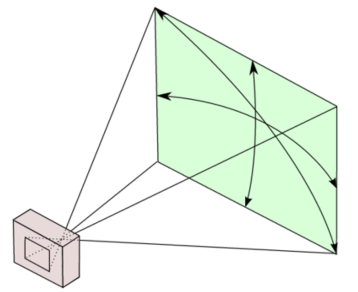

Initialization
The following properties have to be initialized to be able to use the drone. For the particular drone that is used during this project, these properties have the values indicated by <value>:
- SSID <ardrone2>
- Remote host <192.168.1.1>
- Control
- Local port <5556>
- Navdata
- Local port <5554>
- Timeout <1 ms>
- Input buffer size <500 bytes>
- Byte order <litte-endian>
Note that for all properties to initialize the UDP objects that are not mentioned here, MATLAB's default values are used.
After initializing the UDP objects, the Navdata stream must be initiated by following the steps in the picture below.
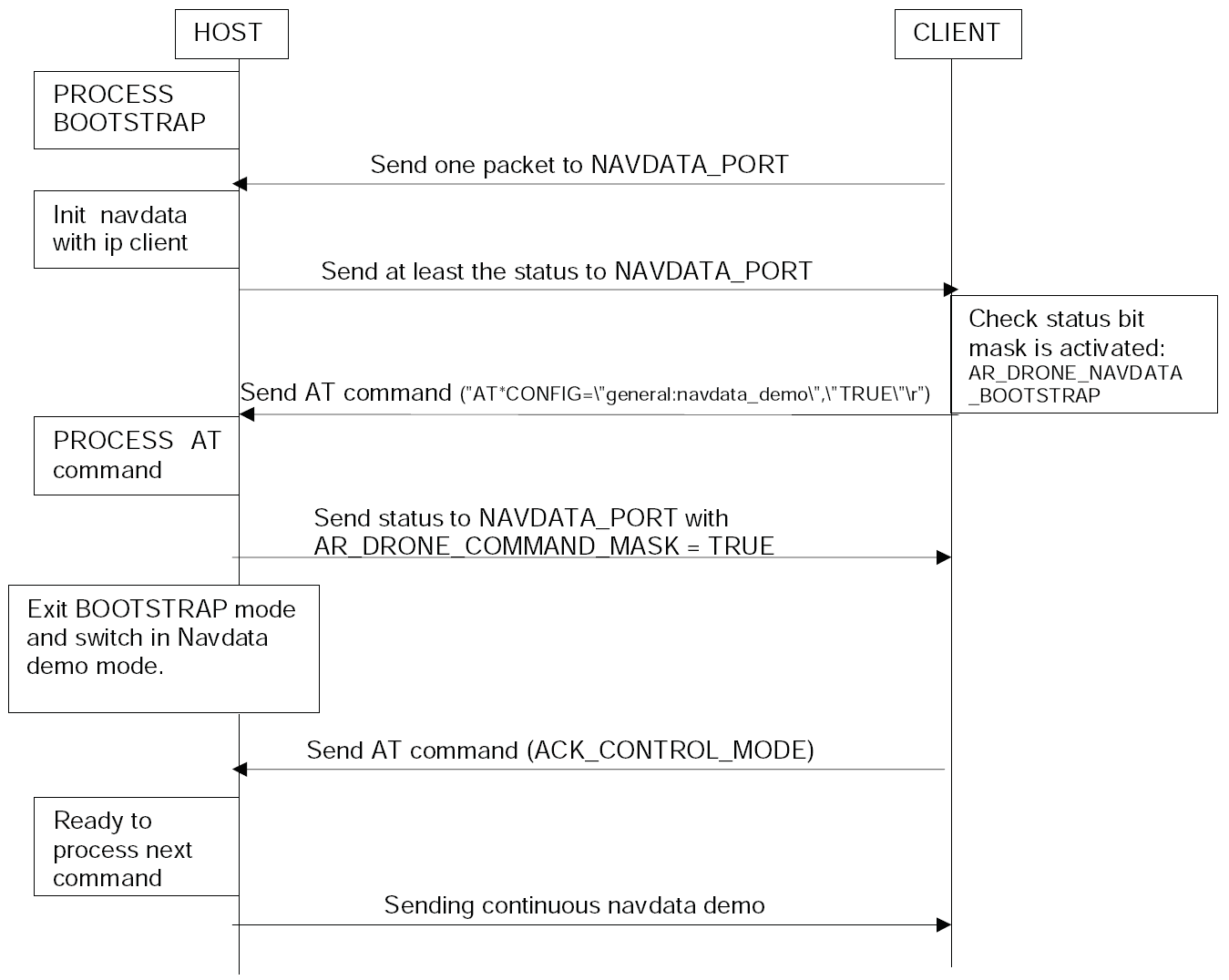
Finally, a reference of the horizontal plane has to be set for the drone internal control system by sending the command FTRIM. [1]
Wrapper
As seen in the initialization, the drone can be seen as a block with expects a UDP packet containing a string as input and which gives an array of 500 bytes as output. To make communicating with this block easier, a wrapper function is written that ensures that the both the input and output are doubles. To be more precise, the input is a vector of four values between -1 and 1 where the first two represent the tilt in front (x) and left (y) direction respectively. The third value is the speed in vertical (z) direction and the fourth is the angular speed (psi) around the z-axis. The output of the block is as follows:
- Battery percentage [%]
- Rotation around x (roll) [°]
- Rotation around y (pitch) [°]
- Rotation around z (yaw) [°]
- Velocity in x [m/s]
- Velocity in y [m/s]
- Position in z (altitude) [m]
Top-Camera
The topcam is a camera that is fixed above the playing field. This camera is used to estimate the location and orientation of the drone. This estimation is used as feedback for the drone to position itself to a desired location. The topcam can stream images with a framerate of 30 Hz to the laptop, but searching the image for the drone (i.e. image processing) might be slower. This is not a problem, since the positioning of the drone itself is far from perfect and not critical as well. As long as the target of interest (ball, players) is within the field of view of the drone, it is acceptable.
Ai-Ball
TechUnited TURTLE
Originally, the Turtle is constructed and programmed to be a football playing robot. The details on the mechanical design and the software developed for the robots can be found here and here respectively.
For this project it was to be used as a referee. All the software that has been developed at TechUnited did not need any further expansion as some part of the extensive code could be used to fulfill the role of the referee. This is explained in the section Software/Communication Protocol Implementation of this wiki-page.
Player
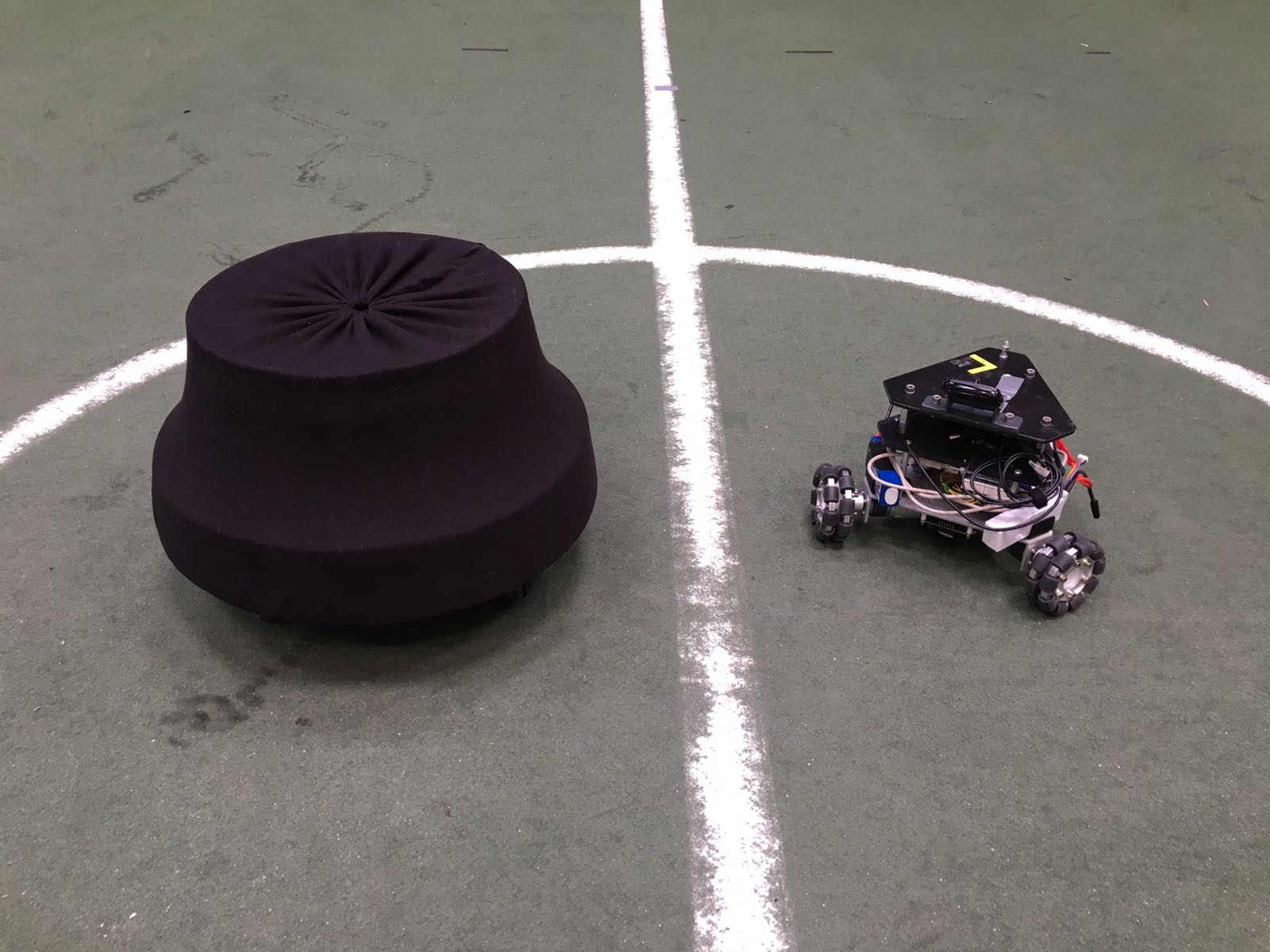
The robots that are used as football players are shown in the picture. In the right side of the picture, the robot is shown as it was delivered at the start of the project. This robot contains a Raspberry Pi, an Arduino and three motors (including encoders/controllers) to control three omni-wheels independently. Left of this robot, a copy including a cover is shown. This cover must prevent the robots from being damaged when they are colliding. Since one of the goals of the project is to detect collisions, it must be possible to collide more than once.
To control the robot, Arduino code and a Python script to run on the Raspberry Pi are provided. The python script can receive strings via UDP over Wi-Fi. Furthermore, it processes these strings and sends commands to the Arduino via USB. To control the drone with a Windows device, MATLAB functions are implemented. Moreover, an Android application is developed to be able to control the robot with a smartphone. All the code can be found on GitHub.[2] >
Supervisory Blocks
Integration
Hardware Inter-connections
The Kinect and the omni-vision camera on the TechUnited Turle allow the robot to take images of the on-going game. With image processing algorithms useful information from the game can be extracted and a mapping of the game-state, i.e.
1. the location of the Turtle,
2. the location of the ball,
3. the location of players
and other entities present on the field can be computed. This location is with respect to the global coordinate system fixed at the geometric center of the pitch. At TechUnited, this mapping is stored (in the memory of the turtle) and maintained (updated regularly) in a real-time data-base (RTDb) which is called the WorldMap. The details on this can be obtained from the software page of TechUnited. In a Robocup match, the participating robots, maintain this data-base locally. Therefore, the Turtle which is used for the referee system, has a locally stored global map of the environment. This information was needed to be extracted from the Turtle and fused with the other algorithms and software that was developed for the drone. These algorithms and software were created on MATLAB and Simulink while the TechUnited software is written in C and uses Ubuntu as the operating system. The player-robots from TechUnited, communicate with each other via the UDP communication protocol and this is executed by the (wireless) comm block shown in the figure that follows.

The basestation computer in this figure is a DevPC (Development PC) from TechUnited which is used to communicate (i.e. send and receive date) with the Turtle. Of all the data that is received from the Turtle, only a part of it was handpicked as it suited the needs of the project the best. This data, as stated earlier is information on the location of the turtle, the ball and the players.
A small piece of code from the code-base of TechUnited was taken out. This piece consisted of functions which extracted the necessary information from the outputs generated by image processing running on the Turtle by listening to this information through the S-funcation sf_test_rMS_wMM.cItalic text created in MATLAB’s environment and sent to the main computer (running on Windows) via the UDP Send and UDP Receive block in Simunlink.
This is figuratively shown in the picture below.

The s-function behind the communication link between the Turtle and the Ubuntu PC was implemented in Simulink and is depicted as follows. The code can be accessed through the repository.